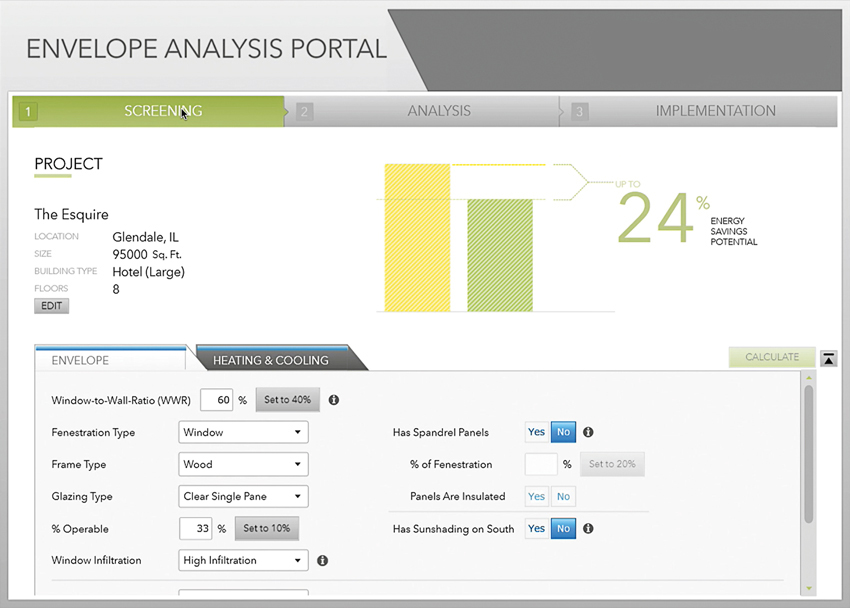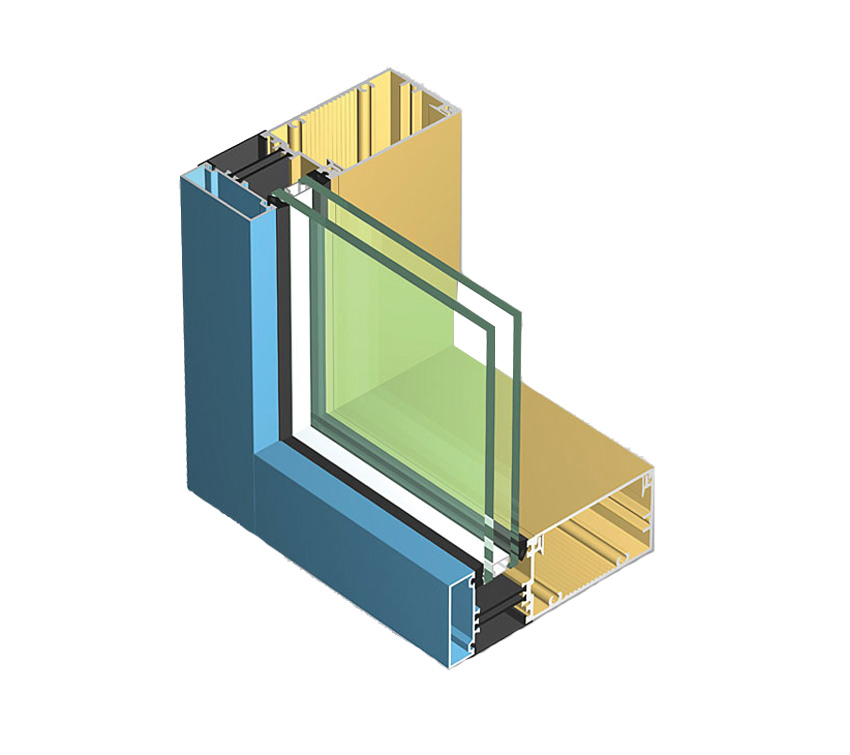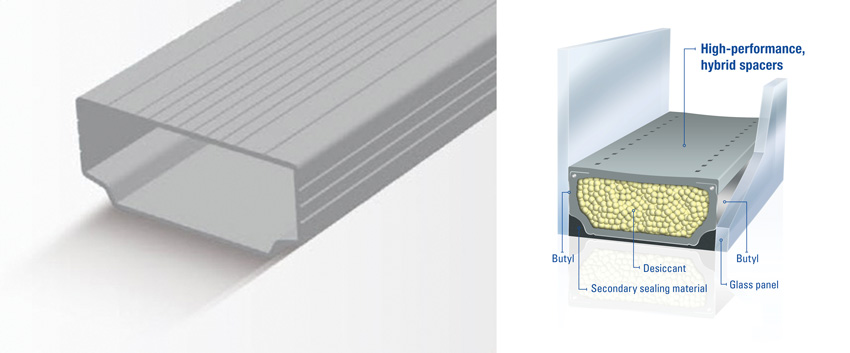Designing for Sustainability
Fenestration Design
The Energy and Atmosphere (EA) category of LEED has always been a major focus of any green building, with up to a third of the possible points available here (33–35 out of a possible 110 in LEED v4). While the USGBC points out that energy should be approached holistically addressing energy use reduction, energy-efficient design strategies, and renewable energy sources, it also emphasizes that it starts with a focus on architectural design that reduces overall energy needs to begin with. This includes design factors, such as building orientation, glazing and fenestration selection, and climate-appropriate wall and roof assemblies. All of these factors can be assessed and analyzed to reveal their impact on energy use in a building, most typically in a computer-simulated energy model, which looks at all of the specific details of a particular building to provide a view of the amount of energy required to operate the building throughout a typical year.
Among the things that can most significantly impact a building’s energy use is the amount and type of windows or other fenestration features in a building. The reason is found in the fact that, while windows are a great and desirable asset for any occupied building, they cannot provide the same energy efficiency performance as an insulated wall. The design challenge on any building, then, is to experiment with the amount of glazed area compared to the insulated wall area (i.e., the window-to-wall ratio) to balance all design criteria while selecting windows that are as energy efficient as possible or practical. This usually requires an iterative process of some trial-and-error variations and options to determine how to optimize a building façade for energy efficiency. Using a computer software tool for that purpose is not only revealing in terms of making a final, informed, design decision, it is probably the only way to do it in a time-efficient manner.
For this type of focused analysis, window manufacturers offer free, customized software and services to help architects and others achieve that optimization. To use this resource, the architect provides the parameters of the building and selects options for windows/glazing systems as part of an overall envelope analysis. These include window area, window-to-wall ratio, glazing types and details, and air-sealing levels. This is an important analysis on any project but especially on the renovation of existing buildings, particularly if the building is being converted from one use (i.e., warehouse, school, etc.) into another, such as multifamily housing, as has become very popular in many areas. In renovation projects, replacing an old, leaky single-pane window with a window that has the latest in thermal performance technology can greatly improve occupant comfort and reduce utility bills. It is also important to pay special attention to sealing up the interface between the window and surrounding condition. Reducing air infiltration at the window perimeter will not only contribute to improved occupant comfort, it can dramatically reduce energy usage.
By working with window manufacturers in this way, multiple options of different window systems in a given building envelope can be analyzed, compared, and assessed. For example, Doug Phelps, director of commercial business development for Pella EFCO Commercial Solutions, points out, “Using envelope analysis, we’re able to analyze and run ‘what-if’ scenarios to compare potential envelope improvements in terms of energy savings, occupant comfort, and building aesthetics. Every project has specific goals, and we are able to support the project team with flexible, real-time analysis.”


Images courtesy of Pella EFCO Commercial Solutions
Software applications, like the one pictured above, help building analysis teams to input a wide range of variables and conditions in new building designs or existing buildings. This information can then help finalize window selections from numerous options, such as those shown here, as part of an overall strategy to optimize energy performance in a building.
Fine-Tuning Fenestration Specifications
Once the best amount of fenestration is determined, attention can turn to the details of that fenestration. In the case of commercial and institutional buildings, the window or fenestration products (e.g., curtain wall, storefront, etc.) often rely on aluminum frames for durability and size customization. The problem with aluminum, however, is that it is a very good conductor of heat, making it a poor choice for thermal energy performance. To overcome that limitation, a thermal break is required to stop or at least slow the flow of heat through the fenestration frame. This is achieved by separating the inside portion of the aluminum frame from the outside portion around the entire perimeter of the unit. In order to maintain its structural integrity, the two halves of the unit still need to be joined, just not with heat-conductive metal. Rather, an alternate material with low heat conductivity is used with enough rigidity to be effective but enough porosity to reduce heat flow. This thermal break approach has been used for decades, but, like most manufactured building products, there are options and variations in performance.
There are two primary thermal break methods available globally. The first is a polyurethane: pour and debridge (P&D) system, which takes the approach of creating a chemical bond between the aluminum frame members. The basic assembly process for a P&D system involves filling a connected aluminum frame with a liquid polyurethane, allowing for curing of the liquid, then cutting away a channel in the metal (debridging) to create the metal separation and thermal break.
The second primary method is to use a polyamide system of connecting strips using a purely mechanical connection. Polyamide is essentially a high-strength, low-conductance nylon that has a similar coefficient of expansion and contraction as aluminum. Some bio-based, renewable alternatives are made from castor oil, extracted from the seeds of the castor oil plant. The basic assembly process for these systems involves crimping into place two polyamide extrusions between the aluminum inner and outer frame pieces to form a composite profile. The composite is then shear tested to ensure structural integrity. Globally, polyamide systems represent the majority share of thermally broken frames. Also note that wider is better in terms of metal separation and thermal performance. This is a strategic approach taken by many manufacturers in today’s fenestration market to offer a good, better, best system of solutions, where the same aluminum profiles can be used and wider polyamide strips can be inserted to significantly improve performance. As an example, Mike Turner, vice president of marketing and technical services at YKK AP America Inc., says, “Our company integrates polyamide pressure plate systems into our curtain wall system to deliver advanced thermal performance on projects with low energy goals.”

Image courtesy of Technoform Group
Polyamide thermal breaks are installed between the inside and outside portions of a fenestration frame to overcome the thermal bridging issue of the metal frames.
With the window or fenestration frame optimized, attention can turn to the details of the glazing itself. Whether used in new or renovation projects, glazing needs to provide a number of different qualities. From a performance standpoint, it can be optimized for daylighting, solar heat gain, or controlling thermal energy loss. This is often achieved not only by the properties of the glass, but through different coatings and tints that can be applied to the glass. Of course, we are well beyond the days of using only single-paned glass in building facades. Instead, multiple-paned insulating glass units (IGUs) are commonly made from different types of glass with different surfaces coated to achieve the desired results. Double-paned glazing has become routine, triple glazing is much more common, and even quadruple glazing is readily available.
This is where another significant detail comes into play for optimizing energy performance. IGUs are manufactured using a spacer that runs between the layers of glass and around the entire perimeter of the glass panels. That spacer is secured in place with a primary sealant adhering the glass completely to the spacer. A secondary sealant, most commonly silicone, is then used outside of the spacer, again around the entire perimeter. Since these spacers can actually represent on the order of 10 to 30 percent of the entire glazed area, reducing the heat transfer through the spacers, just like through the frames, can be significant.
Traditionally, IGU spacers have been made from a single material, such as aluminum, and shaped in the form of box. However, this type creates some notable challenges to performance. Since the aluminum conducts heat, there is not only a lack of any thermal break between the glass panes, it actually creates a thermal bridge around the entire perimeter of the glass. This ends up creating glass edges that are cold—notably colder than the center of the glass where there is no spacer. These colder edges can often be the cause of condensation forming around the perimeter of the glazing, which can potentially cause damage or grow mold. This potential for compromised spacer performance is part of the reason that high-performance fenestration addresses the total performance of a glazing unit, not just the center of the glass.
Recognizing the limitations and problems of traditional, cold-edge spacers, alternative spacers have become available that use improved technology to achieve a genuine “warm edge” that is close to the temperature of the rest of the glass. These warm-edge spacers use materials with lower heat conductivity than aluminum, such as hybrid combinations of foams and plastics strengthened with thin stainless steel. The important point is that this enhanced spacer forms an effective, insulating thermal break such that heat is not conducted through it as in a cold-edge spacer. From an energy standpoint, this improves the U-factor not only of the spacer, but also of the glass and the overall fenestration product. Warmer edges also mean better condensation resistance, which helps with the prevention of moisture accumulation and possible mold growth.

Images courtesy of Technoform Group
Traditional IGU spacers (left) do not prevent thermal bridging across the glass panes, thus creating “cold edges”. By contrast, high-performance, hybrid spacers (right) produce “warm edges” by creating an insulating thermal break between the panes of glass.
Notice

www.efcocorp.com

MitsubishiPro.com/Ready

www.phifer.com/suncontrol/interior/product/
81/8000

SageGlass.com

www.technoform.us










